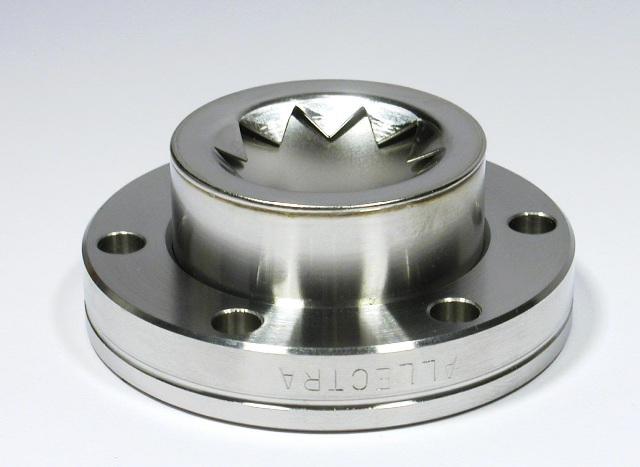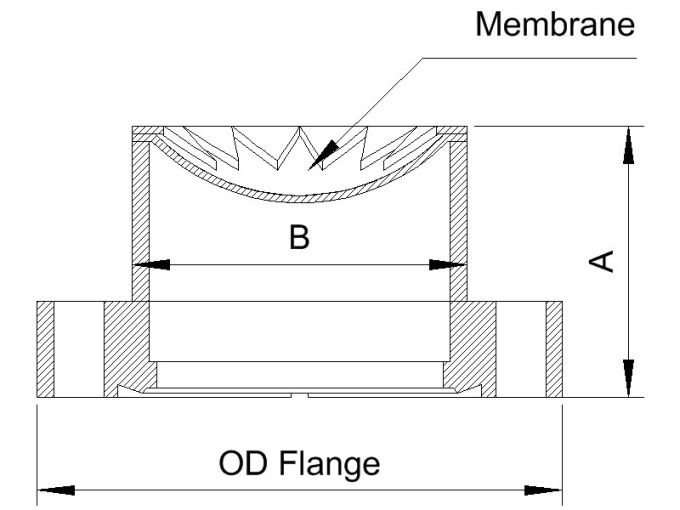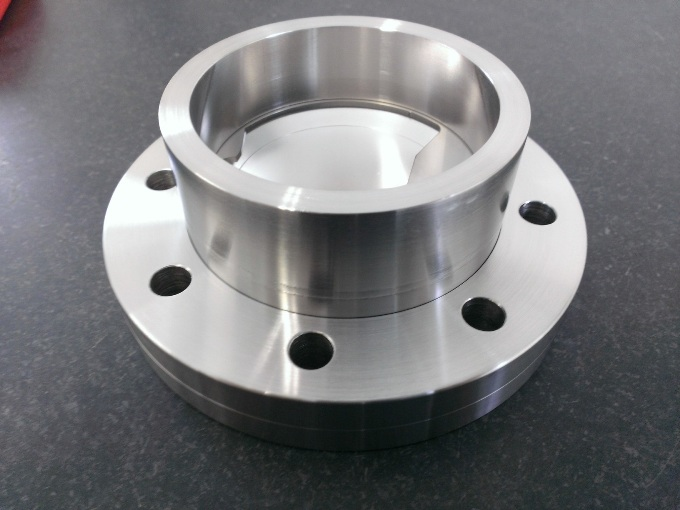Allectra’s UHV Pressure Burst Discs have been developed to rupture and release the gas in a vacuum system during potentially hazardous pressure levels greater than atmospheric pressure.
The UHV Pressure Burst Discs come in three different versions:
- The standard version — the membrane ruptures at a maximum system pressure of 1.7 bar overpressure
- Low-pressure version — the membrane ruptures at a maximum system pressure of 0.8 bar overpressure
- Ultra low-pressure version — the membrane ruptures below the pressure of 0.5 bar; thus, overpressure regulations do not apply to the system

Pressure Burst Disc standard version on 40CF.

Pressure Burst Disc low-pressure version on 40CF.

The Ultra Low-Pressure Burst Disc with a rupture pressure below 0.5 bar on 63CF flange. With this component, overpressure regulations do not apply for the system.
| |
461-PBD
(Standard) |
461-PBD-LP
(Low Pressure) |
461-PBD-ULP
(Ultra Low Pressure) |
| Vacuum |
UHV (<10-10 mbar) |
| Construction |
All metal with 316 Stainless Steel body |
| Temperature |
-200 °C … +350 °C |
Bursting pressure
(at 22 °C) *) |
Typ. 1.2 … 1.4 max. 1.7 bar
(differential) |
Typ. 0.6 ..0.8 max. 0.8 bar
(differential) |
Typ. 0,45 max. 0,48 bar
(differential) |
| Inlet flange |
DN16CF, DN40CF, 16KF, 25KF, 40KF |
DN63CF ISO-K63 |
| Outlet flange |
Optional, Gas recovery only |
-- |
| Flow rates |
DN40CF/40KF: >150 l/sec DN16CF:/16KF > 35 l/sec **) |
>500 l/sec |
*Burst pressure increases at low temperatures up to a factor of 1.8 at −200 °C and reduces at high temperatures up to a factor of 0.7 by 450 °C. Bakeout over 150 °C can increase the maximum burst pressure by a factor of 1.1.
**Versions with gas recovery have a flow rate of >35 L/second for all flange sizes.
Features
- Leak tight to <5 x 10−10 mbar L/second, highly bakeable to a temperature of 350 °C, and UHV compatible
- Safeguards sensitive components against inadvertent overpressure in the vacuum system
- Optional gas recovery system avoids the release of gases into the atmosphere
- DN16CF and DN40CF versions/KF types and custom flanges; ULP version requires 63CF or ISO63 flange.


Ultra-Low-Pressure Burst Disc on 63CF.

Pressure Burst Disc standard version on 16CF.
Dimensions
| |
Standard Version |
Low Pressure Version |
Ultra Low-Pressure Ver. |
| Flange |
16CF |
40CF |
16KF |
40KF |
16CF |
40CF |
16KF |
40KF |
63CF |
ISO-K63 |
| Height A (mm) |
48 |
24 |
48 |
23 |
72 |
72 |
71 |
71 |
47 |
46 |
| Diam. B (mm) |
45 |
45 |
45 |
45 |
59 |
59 |
59 |
59 |
76 |
76 |
| Max. ø (mm) |
45 |
70 |
45 |
55 |
59 |
70 |
59 |
59 |
114 |
95 |
Part Numbers
| Part Code |
Description |
| 461-PBD-C16 |
Standard Pressure Burst Disc on DN16CF flange |
| 461-PBD-C40 |
Standard Pressure Burst Disc on DN40CF flange |
| 461-PBD-K16 |
Standard Pressure Burst Disc on DN16KF flange |
| 461-PBD-K40 |
Standard Pressure Burst Disc on DN40KF flange |
| 461-PBD-C40-K50 |
Standard Pressure Burst Disc 40CF with gas recovery
outlet flange DN50KF |
| 461-PBD-C16-LP |
Low Pressure Burst Disc on DN16CF flange |
| 461-PBD-C40-LP |
Low Pressure Burst Disc on DN40CF flange |
| 461-PBD-K16-LP |
Low Pressure Burst Disc on DN16KF flange |
| 461-PBD-K40-LP |
Low Pressure Burst Disc on DN40KF flange |
| 461-PBD-C40-K50-LP |
Low Pressure Burst Disc 40CF with gas recovery
outlet flange DN50KF |
| 461-PBD-C63-ULP |
Ultra Low Pressure Disk on DN63CF |
| 461-PBD-ISO63-ULP |
Ultra Low Pressure Disk on ISO-K 63 |